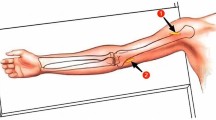Abstract
The minimally invasive percutaneous plate osteosynthesis (MIPPO) technique through the anterior approach has been successfully used in the treatment of humeral shaft fractures and has gained satisfactory clinical outcome. An anatomical study and a preliminary clinic report were performed to evaluate the feasibility of applying the MIPPO technique in the treatment of humeral shaft distal fractures through the lateral approach. This study was done on 14 arms from seven fresh cadavers. The results of this study showed that it is possible to treat humeral shaft distal fractures by using the MIPPO technique through the lateral approach. The results of using the MIPPO technique through the lateral approach in the treatment of humeral shaft fractures in 22 patients were also reviewed.
Résumé
L’ostéosynthèse par plaques par voie mini-invasive (technique MIPPO), après abord antérieur est utilisée avec succès dans le traitement des fractures diaphysaires humérales et permet d’obtenir un bon résultat clinique. Une étude anatomique et une étude clinique préliminaires ont été réalisées pour évaluer la faisabilité de l’utilisation de la technique MIPPO dans le traitement de ces fractures distales par voie latérale. Cette étude a été réalisée sur 14 membres supérieurs de 7 cadavres frais. Les résultats de cette étude montrent qu’il est possible de traiter la fracture de l’humérus distal en utilisant la technique MIPPO par voie latérale. Cette technique, transposée chez 22 patients présentant une fracture de ce type a également été réalisée et évaluée.




Similar content being viewed by others
References
Apivatthakakul T, Arpornchayanon O (2005) Minimally invasive plate osteosynthesis (MIPO) combined with distraction osteogenesis in the treatment of bone defects. A new technique of bone transport: a report of two cases. Injury 36(4):530–538
Fernandez Dell Oca AA (2002) The principle of helical implants. Unusual ideas worth considering. Injury Suppl 33:19–27
Frigg R (2001) Locking compression plate (LCP): an osteosynthesis plate based on the dynamic compression plate and point contact fixator (PCFix). Injury 32(Suppl 2):636
Frigg R (2003) Development of the locking compression plate. Injury 34(Suppl 2):B6–B10
Gerwin M, Hotchkiss RN, Weiland AJ (1996) Alternative operative exposures of the posterior aspect of the humeral diaphysis with reference to the radial nerve. J Bone Joint Surg Am 78-A:1690–1695
Heim D, Herkert F, Hess P, Regazzni P (1993) Surgical treatment of humeral shaft fracture: the Basel experience. J Trauma 35:22632
Heitemeyer U, Kemper F, Hierholzer G, Haines J (1987) Severely comminuted femoral shaft fracture: treatment by bridging plate osteosynthesis. Arch Orthop Trauma Surg 106:327–330
Helfet DL, Shonnard PY, Levine D, Borrelli J Jr(1997) Minimally invasive plate osteosynthesis of distal fractures of the tibia. Injury 28(Suppl 1):428
Henle MB (1993) Humeral shaft fracture. In: Hansen ST, Swiontkowski MF (eds) Orthopedic trauma protocols. Raven Press, New York, pp 91–95
Ji Fang, Yang Tie-yi, Wang Ming-chun et al (2005) Anatomic analysis of MIPPO technique in treatment of humeral fractures: a preliminary clinic report. Chinese J Orthop Trauma 7(12):1128–1131
Lau TW, Leung F, Chan CF, Chow SP (2007) Minimally invasive plate osteosynthesis in the treatment of proximal humeral fracture. Int Orthop 31(5):657–664
Perren SM (2002) The technology of minimally invasive percutaneous osteosynthesis (MIPO). Injury 33(Suppl 1):VI–VII
Perren SM (2002) Evolution of the internal fixation of long bone fractures. The scientific basis of biological internal fixation: choosing a new balance between stability and biology. J Bone Joint Surg Br 84(8):1093–1110
Stoffel K, Dieter U, Stachowiak G, Gachter A, Kuster MS (2003) Biomechanical testing of the LCP-how can stability in locked internal fixators be controlled? Injury 34(Suppl 2):B11–B19
Wagner M (2003) General principles for the clinical use of the LCP. Injury 34(Suppl 2):B31–B42
Wagner M, Frenk A, Frigg R (2004) New concepts for bone fracture treatment and the locking compression plate. Surg Technol Int 12:271–277
Zhiquan A, Bingfang Z, Yeming W, Chi Z, Peiyan H (2007) Minimally invasive plating osteosynthesis (MIPO) of middle and distal third humeral shaft fractures. J Orthop Trauma 21(9):628–633
Author information
Authors and Affiliations
Corresponding author
Rights and permissions
About this article
Cite this article
Ji, F., Tong, D., Tang, H. et al. Minimally invasive percutaneous plate osteosynthesis (MIPPO) technique applied in the treatment of humeral shaft distal fractures through a lateral approach. International Orthopaedics (SICOT) 33, 543–547 (2009). https://doi.org/10.1007/s00264-008-0522-2
Received:
Revised:
Accepted:
Published:
Issue Date:
DOI: https://doi.org/10.1007/s00264-008-0522-2




